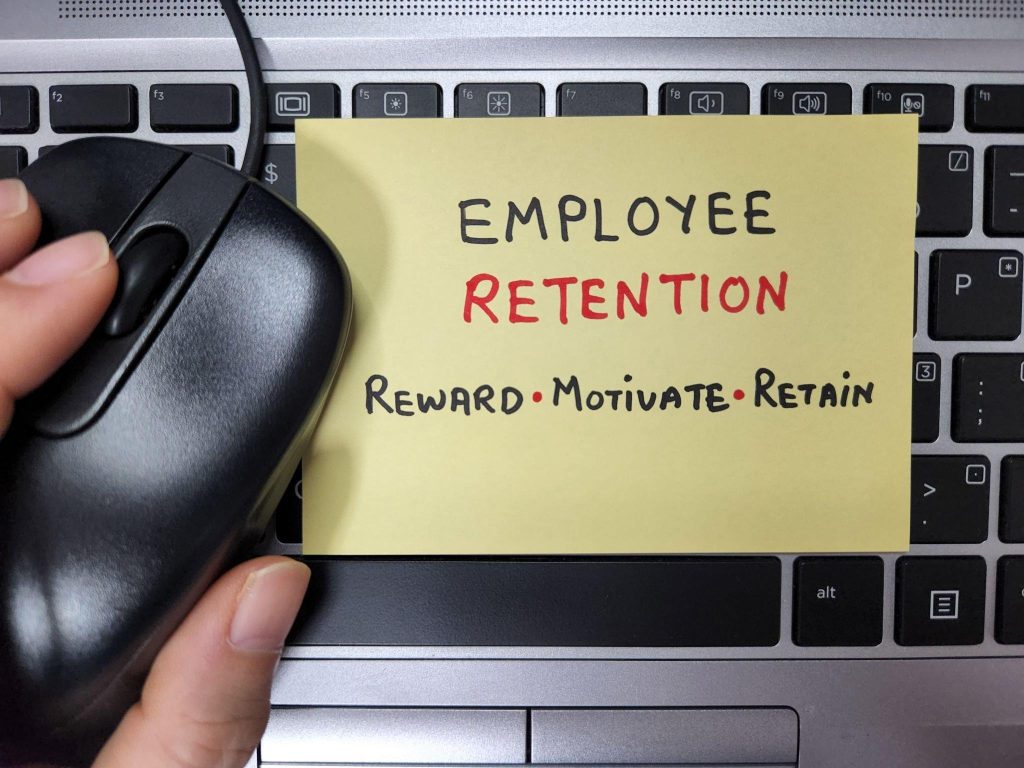Last Updated on June 7, 2023

If you’re reading this article, chances are you have heard about or experienced, employee retention. You’ve either experienced the frustration of losing a valuable employee or you’re a business owner looking to avoid that situation altogether. Either way, you’re in the right place!
Employee retention has become a hot topic in today’s job market, and for good reason. With unemployment rates at historic lows, competition for top talent is fierce. And, let’s be honest, nobody wants to constantly play the recruitment and training game. It can be a huge drain on time, resources, and morale.
That’s why it’s so crucial for companies to focus on retaining their employees. It’s not just about keeping the numbers up on your employee roster. When you have a stable and engaged workforce, the benefits ripple throughout your organization, from improved productivity to a better reputation in the community.
So, whether you’re a seasoned HR professional or a small business owner just starting to consider the importance of employee retention, get comfortable while we dive in.
Advantages of Employee Retention
Okay, let’s talk about the juicy stuff—why retaining your employees is actually worth the effort!
First up: increased productivity. When your employees feel valued and supported, they’re more likely to be fully engaged in their work and go above and beyond what’s expected. That means better output and more efficient use of resources for your business. Score!
Next, improve employee morale. When you invest in your employees and show them that you value their contributions, it creates a positive work environment. Happy employees are more likely to stay with your company and spread the love to their coworkers. A positive work environment not only makes for a more enjoyable place to work, but also makes for a more productive one.
Third, better customer satisfaction Your employees are the face of your company, and if they’re happy, it shows in the quality of service they provide to your customers. Happy employees lead to happy customers, which leads to repeat business and a positive reputation in the community.
Fourth, lower recruitment and training costs This one is a no-brainer. When you have a high employee turnover rate, you’re constantly spending time and resources on finding, interviewing, and training new hires. When you have a stable workforce, you can focus on other areas of your business and save money in the long run.
Last but certainly not least, enhanced reputation Companies with a reputation for treating their employees well are more attractive to both customers and job candidates. It’s a win-win situation: happy employees help attract more business and top talent to your company.
So there you have it. Employee retention isn’t just about keeping your numbers up; it’s about improving your business in every aspect. Who wouldn’t want that?
Read: What is Asset Allocation and How to Apply It
Are there challenges?
All right, now that we’ve talked about the good stuff, let’s get real. Yes, there are challenges to employee retention and they are real.
First on the list is competition from other companies. When unemployment is low, top talent has options. If your company isn’t offering what employees are looking for, they’ll be quick to jump ship for a better opportunity. Keeping up with the competition can be tough, but it’s essential if you want to retain your employees.
Second, lack of growth opportunities Employees want to feel like they’re making progress in their careers, and if your company can’t offer them that, they’ll look for it elsewhere. Providing opportunities for professional development and growth is key to retaining your employees.
Third, poor management and leadership Nobody wants to work for a boss who micromanages or doesn’t listen to their employees. If your management style causes your employees to feel undervalued or disrespected, they’re more likely to leave.
Fourth, there is inadequate compensation and benefits. Let’s face it, money matters. If your employees feel like they’re not being fairly compensated for their work, they’ll look for a company that values them more. Offering competitive compensation and benefits is crucial to retaining your employees.
Last but not least, unsatisfactory working conditions This can include things like long hours, a lack of work-life balance, or a stressful work environment. When employees don’t feel like they’re being treated well, they’re more likely to leave.
So there you have it: the challenges of employee retention in a nutshell. It’s not always easy, but understanding and addressing these challenges is crucial to retaining your employees and keeping your business running smoothly.
Strategies for Improving Employee Retention
To improve the employee retention rate in your company, there are certain strategies you can sieve through and implement, according to what works best for the company and the employee. Some of these strategies are as follows:
1. Creating a Positive Work Environment
Having a positive work environment can never be overestimated. Now imagine the “never” in all caps. Yes, it’s that important. However, not every workplace has been able to implement or create it, so let’s give you a roadmap.
First, open and effective communication is key. Encourage your employees to speak up and provide regular opportunities for feedback. When employees feel heard and that their opinions matter, they’re more likely to feel valued and engaged.
Second, provide opportunities for professional growth and development. This can be in the form of training, workshops, or even tuition reimbursement. When employees feel like they’re growing in their careers, they’re less likely to look for opportunities elsewhere.
Third, make sure your employees are fairly compensated and have access to good benefits. Money talks, folks. If your employees feel like they’re not being fairly compensated, they’ll be quick to leave.
Fourth, promote work-life balance. This can mean flexible work arrangements, paid time off, or simply making sure your employees aren’t overextended. When employees feel like their job isn’t taking over their life, they’re more likely to be happy and engaged in their work.
Last but not least, lead by example. Make sure your management and leadership are setting a positive tone for the rest of the company. This includes treating employees with respect, leading with empathy, and creating a supportive work environment.
So there you have it. Creating a positive work environment is about making sure your employees feel valued, supported, and happy in their work. When you do that, you’ll see the benefits ripple throughout your organization.
2. Offering Competitive Compensation and Benefits
It is a fact that people work more efficiently when offered competitive compensation and benefits. This is the big leagues.
First things first, you’ve got to pay your employees what they’re worth. I mean, it’s only fair. If your employees feel like they’re not being paid enough, they’ll be quick to jump ship for a company that values them more.
Next up, benefits. These can include things like health insurance, retirement plans, paid time off, and more. The key here is to offer benefits that your employees actually want and will use. There’s no point in offering benefits that nobody wants; it’s just a waste of money.
It’s also important to stay on top of what other companies in your industry are offering. Do your research, see what your competitors are doing, and make sure you’re offering competitive compensation and benefits to stay ahead of the game.
Finally, be upfront and clear about your compensation and benefits packages. Make sure your employees understand what they’re eligible for and how to access these benefits. The more transparent and clear you are, the more your employees will trust you and feel valued.
3. Providing Professional Development Opportunities
Every intentional employee goes head-first into a job role because they believe, in a matter of time, after they have put in the work, they will be rewarded. They will be provided with professional development opportunities. Honestly, they are entitled to it, and employers need to know that.
First and foremost, it’s important to invest in your employees. When you provide opportunities for them to grow and develop professionally, they’re more likely to feel valued and engaged in their work.
This can come in many forms, such as training, workshops, or even tuition reimbursement. The key is to find what works best for your employees and provide opportunities that align with their career goals.
It’s also important to provide opportunities for employees to stretch themselves and take on new challenges. When employees feel like they’re growing in their careers and taking on new responsibilities, they’re less likely to look for opportunities elsewhere.
Finally, make sure you’re tracking your employees’ professional development and celebrating their successes along the way. This can mean regular performance evaluations, setting goals, and recognizing achievements.
So there you have it. Providing professional development opportunities is about investing in your employees, helping them grow in their careers, and making sure they feel valued and supported. When you do that, you’ll see the benefits ripple throughout your organization.
4. Encouraging Open Communication and Feedback
First and foremost, it’s important to create an environment where employees feel comfortable sharing their thoughts and ideas. When employees feel like they’re being heard and that their opinions matter, they’re more likely to feel engaged and invested in their work.
This can be achieved through regular check-ins, team meetings, and performance evaluations. Encourage employees to share their thoughts and feedback, and make sure you’re actively listening and considering their perspectives.
It’s also important to provide opportunities for employees to give feedback to their managers and leaders. When leaders are open to feedback and actively seek it out, they’re more likely to create a culture of trust and transparency.
Finally, make sure you’re acting on the feedback you receive. This can mean making changes to processes, addressing concerns, and recognizing and celebrating successes. When employees see that their feedback is being taken seriously and acted upon, they’re more likely to feel valued and engaged.
So there you have it. Encouraging open communication and feedback is all about creating a culture of trust and transparency where employees feel heard and valued. When you do that, you’ll see the benefits ripple throughout your organization.
Conclusion
The importance of employee retention in today’s job market cannot be overstated. With the job market being as competitive as it is, companies need to do everything in their power to keep their employees happy and engaged.
From offering competitive compensation and benefits to providing professional development opportunities to encouraging open communication and feedback, there are a lot of things companies can do to improve employee retention.
But at the end of the day, it all comes down to one thing: making your employees feel valued and supported. When employees feel like they’re part of a team and are contributing to a larger goal, they’re less likely to head for the exits.
So, companies, the ball is in your court. It’s time to step up and make employee retention a top priority. Your employees and your bottom line will thank you for it.
Before you go…
Hey, thank you for reading this blog to the end. I hope it was helpful. Let me tell you a little bit about Nicholas Idoko Technologies. We help businesses and companies build an online presence by developing web, mobile, desktop, and blockchain applications.
We also help aspiring software developers and programmers learn the skills they need to have a successful career. Take your first step to becoming a programming boss by joining our Learn To Code academy today!
Be sure to contact us if you need more information or have any questions! We are readily available.











